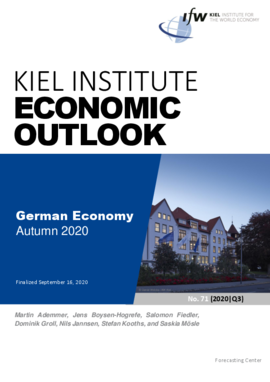Authors
Publication Date
Key Words
Related Topics
Labor Market
Fiscal Policy & National Budgets
Business Cycle Germany
The German economy is recovering from the COVID-19 shock. With the successful containment of the coronavirus, output has quickly rebounded from its trough in April and has made up a good part of the losses within a few months. This strong momentum essentially reflects the normalization of economic activity after the lockdown. Further recovery is likely to be much more gradual. Some industries are still noticeably affected by the pandemic. Foreign business is also likely to suffer for some time, particularly as infections have recently threatened to flare up again in many places and important export destinations have been hit hard by the crisis. Against this backdrop, companies will be cautious with investments for the time being, especially because there is still uncertainty about how long the pandemic will weigh on business activity. By contrast, private consumer spending is likely to recover more rapidly as private households will normalize their savings rate, which had swollen to record levels during the lockdown, and as labor incomes will be stimulated by the recovery at the labor market. For the current year, we expect GDP to decline by 5.5 percent. The upward revision of 1.3 percentage points compared to our summer forecast is mainly due to the fact that the rebound began earlier than expected. Accordingly, we have reduced our forecast for GDP growth in 2021 to 4.8 percent (summer forecast: 6.3 percent). With a further increase in GDP of 2.4 percent in 2022, capacity utilization is by and large expected to return to normal levels. The fiscal balance will slide into a significant deficit of 5 percent in 2020. The debt-to-GDP ratio increases from almost 60 percent to more than 70 percent. Despite the economic recovery, public budgets will be in deficit throughout the entire forecast period











